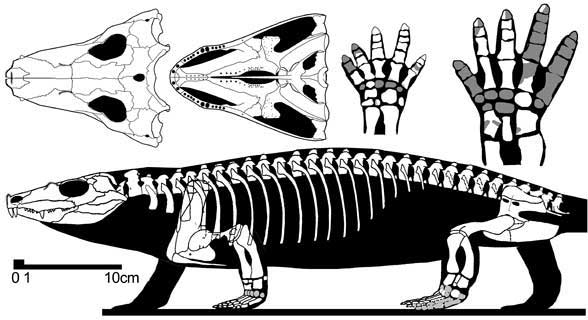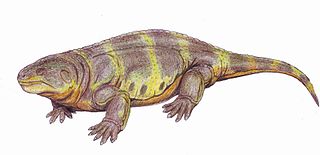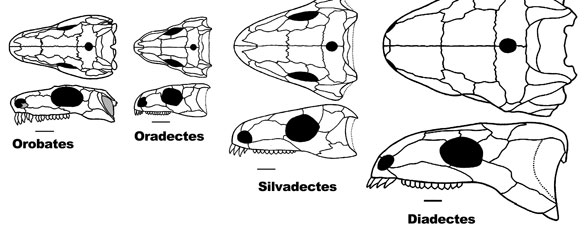 Diadectomorpha:
Limnoscelis, Diadectes, Tseiajaia.
Diadectomorpha:
Limnoscelis, Diadectes, Tseiajaia.| Reptiliomorpha | ||
| The Vertebrates | Diadectomorpha |
| Vertebrates Home | Vertebrate | Vertebrate |
|
Abbreviated Dendrogram
Tetrapoda
├─Temnospondyli
└─┬─Lepospondyli
│
└─Reptiliomorpha
├─Anthracosauroidea
└─┬─Gephyrostegidae
└─Batrachosauria
├─Seymouriamorpha
└─┬─Solenodonsaurus
└─Cotylosauria
├─Diadectomorpha
│ ├─Tseajaia
│ └─┬─Limnoscelis
│ └─Diadectidae
└─┬─Solenodonsaurus
└─Cotylosauria
├─Diadectomorpha
└─Amniota
|
Contents
Overview |

Limnoscelis paludis (Diadectomorpha - Limnosceliidae),
Early Pemian, Texas and New Mexico
an animal very close to the ancestry of amniotes. Length about 1.5 meters
life reconstruction, by Dmitry Bogdanov (Larger image (Wikimedia))
Included here are animals so reptile like they might as well be reptiles. In evolutionary systematics books they were considered reptiles, but cladistic analysis places them outside the Crown Group Amniotes, so they are now generally considered anamniotes (non-amniotes, as amphibian is a paraphyletic taxon and hence now depreciated). Although it is possible that they may still be apomorphic amniotes, as egg-laying animals may have evolved long before the evolutionary divergence into Sauropsids and Synapsids, other factors would seme to indicate an amphibian status, such as large size (whereas both proto-amniotes and many early crown amniotes were generally very small, allowing for a transitional stage of less efficient amniote eggs). On the other hand, as far no diadectomorph had lateral-line canal grooves (indicating fish-like aquatic pressure sensing), and no diadectomorph tadpole is known. In contrast seymouriomorphs, an important group of reptile-like amphibians (reptiliomorphs), had tadpole young, and hence were not amniotes. Moreover, diadectomorphs even tend to be placed higher (more amniote-ward, or even (in one supertree analysis) within the amniote crown (Ruta et al 2003b)) than forms like Westlothiana and Casineria, each considered the first reptile when first discovered, and posessing a number of classic amniote features. For now we have retained the diadectomorphs among the repyile-like amphibians (reptiliomorphs), although they may just as easily be an early group of stem group amniotes or, to use the old classification, primitive reptiles. MAK111108 120321
.from the Carboniferous.
Batrachosauria : Seymouriamorpha + (Solenodonsaurus + * : Diadectomorpha + Stem Amniota)
$ more derived axis-atlas complex; $ sacrum with at least 2 vertebrae, $ robust claws on pes; $ loss of lateral line system.
Links: Phylogeny of Stegocephalians; AMPHIBIA et REPTILIA NGIANA (Chinese); V The four other mass extinctions. ATW020623.
 Diadectomorpha:
Limnoscelis, Diadectes, Tseiajaia.
Diadectomorpha:
Limnoscelis, Diadectes, Tseiajaia.
Late Carboniferous to Early Permian.
Cotylosauria : Stem Amniota + * : Tseajaia + (Limnoscelis + Diadectidae) .
1.5-3 m; some fully terrestrial; "swollen" neural arches; some (Diadectes) herbivorous.
Links: Diadectomorpha; Phylogeny of stegocephalians (note figures of Limnoscelis); Biology 356.
Image: Diadectes. ATW030122.

Tseajaia campi Vaughn 1964
Diadectomorpha: (Limnoscelis + Diadectidae) + *. or Limnoscelis + (Diadectidae + *).
Comments: Traditionally considered the most primitive diadectomorphs, although a recent analysis (Kissel 2010) makes them the sister group to the diadectidae. Limnoscelid-like in appaerance, but tending to an omnivorous or herbivorous diet. Only one species is known, a single late surviving form, essentially a "living fossil" co-existing with its more advanced and successful contemporaries. From Wikipedia: Tseajaia was described from a single, fairly complete specimen and was given its own family by Robert L. Carroll. It was originally thought to be an seymouriamorph (Moss 1972) Additional finds allowing for a better taxonomic analysis indicate they belong in the Diadectomorpha, as the sister group to the large and more derived Diadectidae. Tseajaia itself being a fairly generalized form, gives a reasonable indication of the build and looks of the closest relatives of the amniotes (Berman et al 1992, Kissel 2010)
Image: David Peters, Reptile evolution MAK111107
Late Carboniferous to Early Permian.
Diadectomorpha : Tseajaia + * ::: Diadectidae.
Comments: Primitive, small to large, carnivorous diadectomorphs. These animals must have lived a very similar life to ophaicodontid, varanopsid, and sphenacodontid pelycosaurs,which they resembled in overall size and shape; presumably relied on niche partitioning. Teeth retained labyrinthodont infolding of the enamel, and were pointed and slightly recurved at the tip (Carroll 1967, via Wikipedia) Traditionally divided into two genera, Limnoscelis and Limnostygis, although these may be synonyms
Diadectidae: Desmatodon, Diadectes, , etc
Late Carboniferous to Early Permian of Europe and North America.
Diadectomorpha ::: *.
Comments: Highly successful clade of large herbivores, include the largest animals of their time and teh first exploitation of vegetable matter by tetrapods. Previously tentrapods (amphibians and reptiles() had been carnivores only, feeding on insects, crustacea and other invertebrates, fish, and smaller tetrapods. This means that eco\ystems were inefficent (becaise of long food chains, and tied to water or water margins. While edphosaurs were also herbivores, they never challenged the supremacy of the diadectids. Diadectid extinction at the end of the early Permian allowed caseid pelycosaurs to replace them as the large herbivores; they were in turn replaced by herbivousrous therapsids (dinocephalia and anomodonts) later in the Permian.
Link Wikipedia
Image: Diadectes phaseolinus, American Museum of Natural History, New York, photo by Ghedoghedo, Wikipedia MAK111107
 Left: Life reconstruction of Diasparactus zenos, by Dmitry Bogdanov . Length 1.35 metres. Wikipedia, GNU Free Documentation/Creative Commons Attribution Below Left: the skulls of Orobates, Oradectes, Silvadectes and Diadectes from Kissel 2010, via David Peters, Reptile evolution. Scale bar = 2 cm. Below Right: Cladogram from Kissel 2010 via Wikipedia: 
Diadectomorpha:
└─┬─Limnoscelidae
└─┬─Tseajaiidae
└─Diadectidae
├──Ambedus pusillus
└─┬─Oradectes sanmiguelensis
└─┬─Orobates pabsti
└─┬─Desmatodon hesperis
└─┬─Silvadectes absitus
└─┬─Diadectes tenuitectes
├─Diadectes sideropelicus
└─Diasparactus zenos
|
checked ATW050518, revised MAK111107, 120321